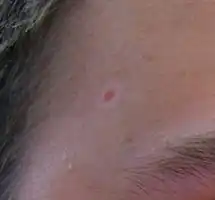Halo nevus
| Halo nevus | |
|---|---|
| Other names: Leukoderma acquisitum centrifugum, perinevoid vitiligo, Sutton nevus[1] | |
.jpg.webp) | |
| Halo nevus - dark spot with surrounding pale area | |
| Specialty | Dermatology |
| Symptoms | One or more dark spot with surrounding pale area, typically on chest but anywhere[1] |
| Usual onset | Children, young adults[1] |
| Risk factors | Vitiligo, Turner's syndrome, infliximab[2] |
| Diagnostic method | By its appearance, dermoscopy[2] |
| Differential diagnosis | Melanoma[1] |
| Treatment | Usually none[2] |
| Frequency | 1% of general population, males=females[1] |
Halo nevus is a mole that is surrounded by a pale ring or 'halo'.[1] It is generally noticed in the summer, when surrounding skin tans, and usually occurs on the chest, but can be anywhere.[1] There may be one or more typically several.[2] Onset is usually in teenagers and young adults.[1][3] It typically follows a pattern of appearing at first as a dark mole surrounded by a halo before the nevus fades and disappears.[1] A single halo nevus like lesion appearing in an older adult may be a melanoma.[1]
The central dark part tends to turn pink before becoming pale, and then its color returns.[2] Halo nevi are associated with vitiligo, Turner's syndrome, and treatment with infliximab.[2] The formation of a halo surrounding a nevus is believed to occur when certain white blood cell destroy the pigment-producing cells of the skin.[2]
It occurs in around 1% of general population, and males and females are affected equally.[1]
Signs and symptoms
It appears as a mole that is surrounded by a pale ring or 'halo'.[1]
.jpg.webp) Halo mole
Halo mole.jpg.webp) Halo mole
Halo mole Photograph of a halo nevus on a face
Photograph of a halo nevus on a face
Causes
The formation of a halo surrounding a nevi is believed to occur when certain white blood cells called CD8+ T lymphocytes destroy the pigment-producing cells of the skin (melanocytes).[2]
Treatment
As halo nevi are only of cosmetic significance, no treatment is required.[2]
Epidemiology
Halo nevi are estimated to be present in approximately 1% of the general population.[1] All races and sexes are equally susceptible.[1] The average age of onset is in a person's teenage years.[1]
See also
References
- 1 2 3 4 5 6 7 8 9 10 11 12 13 14 15 DE, Elder; D, Massi; RA, Scolyer; R, Willemze (2018). "2. Melanocytic tumours: halo naevus". WHO Classification of Skin Tumours. Vol. 11 (4th ed.). Lyon (France): World Health Organization. pp. 91–92. ISBN 978-92-832-2440-2. Archived from the original on 2022-07-11. Retrieved 2022-08-12.
- 1 2 3 4 5 6 7 8 9 James, William D.; Elston, Dirk; Treat, James R.; Rosenbach, Misha A.; Neuhaus, Isaac (2020). "30. Melanocytic nevi and neoplasms: halo nevus". Andrews' Diseases of the Skin: Clinical Dermatology (13th ed.). Edinburgh: Elsevier. pp. 690–691. ISBN 978-0-323-54753-6. Archived from the original on 2022-08-23. Retrieved 2022-08-12.
- ↑ Johnstone, Ronald B. (2017). "32. Lentigines, nevi and melanomas". Weedon's Skin Pathology Essentials (2nd ed.). Elsevier. p. 536. ISBN 978-0-7020-6830-0. Archived from the original on 2021-05-25. Retrieved 2022-08-12.
External links
| Classification | |
|---|---|
| External resources |